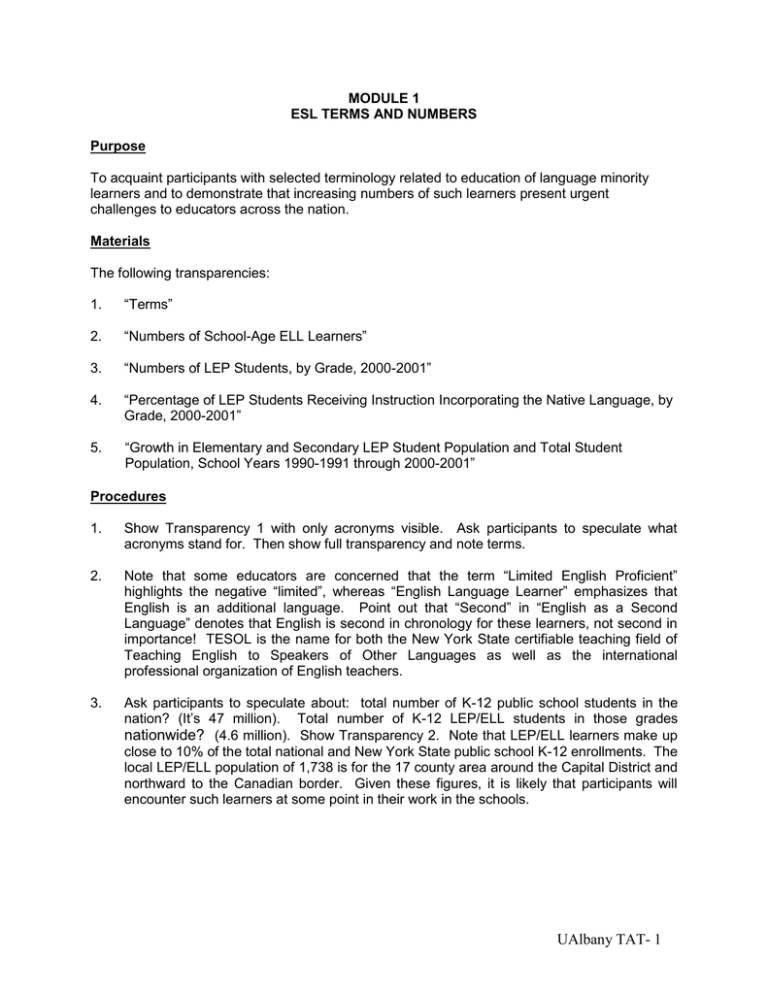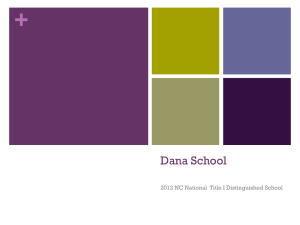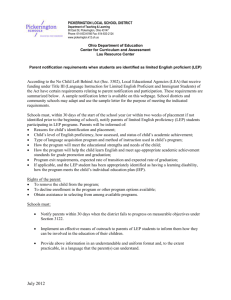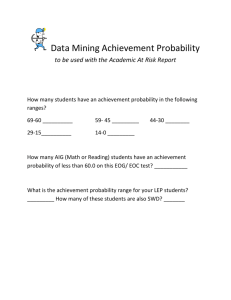Module 1 ESL Terms and Numbers
advertisement

MODULE 1 ESL TERMS AND NUMBERS Purpose To acquaint participants with selected terminology related to education of language minority learners and to demonstrate that increasing numbers of such learners present urgent challenges to educators across the nation. Materials The following transparencies: 1. “Terms” 2. “Numbers of School-Age ELL Learners” 3. “Numbers of LEP Students, by Grade, 2000-2001” 4. “Percentage of LEP Students Receiving Instruction Incorporating the Native Language, by Grade, 2000-2001” 5. “Growth in Elementary and Secondary LEP Student Population and Total Student Population, School Years 1990-1991 through 2000-2001” Procedures 1. Show Transparency 1 with only acronyms visible. Ask participants to speculate what acronyms stand for. Then show full transparency and note terms. 2. Note that some educators are concerned that the term “Limited English Proficient” highlights the negative “limited”, whereas “English Language Learner” emphasizes that English is an additional language. Point out that “Second” in “English as a Second Language” denotes that English is second in chronology for these learners, not second in importance! TESOL is the name for both the New York State certifiable teaching field of Teaching English to Speakers of Other Languages as well as the international professional organization of English teachers. 3. Ask participants to speculate about: total number of K-12 public school students in the nation? (It’s 47 million). Total number of K-12 LEP/ELL students in those grades nationwide? (4.6 million). Show Transparency 2. Note that LEP/ELL learners make up close to 10% of the total national and New York State public school K-12 enrollments. The local LEP/ELL population of 1,738 is for the 17 county area around the Capital District and northward to the Canadian border. Given these figures, it is likely that participants will encounter such learners at some point in their work in the schools. UAlbany TAT- 1 Transparency 1 Terms ELL = English Language Learners (Gradually replacing LEP) LEP = Limited English Proficient ESL = English as a Second Language TESOL = Teaching English to Speakers of Other Languages Bilingual Education = a program utilizing two languages as mediums of instruction Dual Language Program = a bilingual program for both language majority and language minority learners UAlbany TAT- 2 Transparency 2 Numbers of School-age ELL Learners NATIONAL: 4.6 million (of 47 million) K-12 public school students are LEP/ELL NEW YORK STATE: 239,000 (of 2.8 million) public school students are LEP/ELL LOCALLY: 1,738 students are LEP/ELL (17 county area) Source for national and New York State numbers: Kindler, Anneka. 2002. "Survey of States' Limited English Proficient Students and Available Educational Programs and Services. 2000-2001 Summary Report." Washington, O.C.: National Clearinghouse for English Language Acquisition and Language Instruction Educational Programs. Retrieved from www.ncela.gwu.edu June 8,2003. Source for local number: Adam, William. Specialist, Northeast Regional Information Center, Capital Region BOCES, Albany, NY. (Personal Communication, June 2003) UAlbany TAT- 3 4. Show only the title of Transparency 3. Have participants speculate on which grades have the largest LEP/ELL populations. Show the full transparency, noting that LEP populations are concentrated in the lower grades. What might be some explanations for this? Note also the increase in LEP/ELL numbers from grade 8 to grade 9. What factors might account for this? 5. As background for Transparency 4, note some pros and cons of instruction incorporating the native language of LEP learners. (Examples: pro = learners more likely to understand instruction; facilitates closer home-school connections; literacy in a first language facilitates literacy in English, etc; con = greater costs in short term). 6. Show Transparency 4. Have participants describe some of the facts illustrated on this chart. Have them discuss some implications of these facts. What are the implications, for example, of these instructional patterns for developing and maintaining bilingualism in learners? For maintaining literacy in a language like Spanish which will enable Hispanic background students to read classics such as Cervantes in their heritage language? Elicit participants’ views of these issues. 7. Show the title only of Transparency 5. Have participants speculate about the growth rates of LEP K-12 student populations contrasted with total K-12 student populations over the past decade. By what percentage did each population grow during those 10 years according to participants’ guesses? Show all of Transparency 5. How close were they? What are some factors that might help explain the disparity in growth rates? Ask participants if they expect these growth rates to be sustained. Why or why not? Note again that, given these numbers and rates of population growth, most participants are likely to experience first hand the challenges of working with LEP learners. The readings noted below and in other modules will assist in meeting these challenges. Further reading Baker, Colin. 1996. Foundations of bilingual education and bilingualism. Philadelphia, PA.: Multilingual Matters Ltd. Center for Applied Linguistics and Delta Systems Company. 1999. Enriching content classes for secondary school students: Study guide and Trainer’s manual. Washington, D.C.: Author. Meskill, Carla. 2002. Teaching and learning in real time: Media, technologies, and language acquisition. Houston, TX: Athelstan. New York State Education Department. 2000. The teaching of language arts to limited English proficient/English language learners: A resource guide for all teachers. Albany, NY: Author. UAlbany TAT- 4


